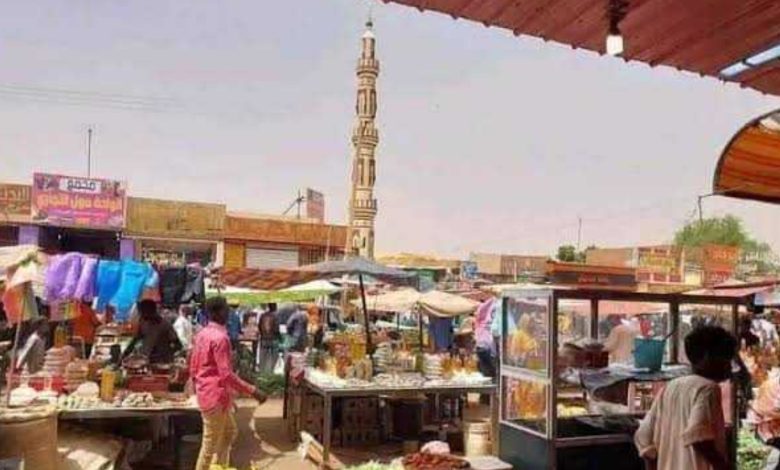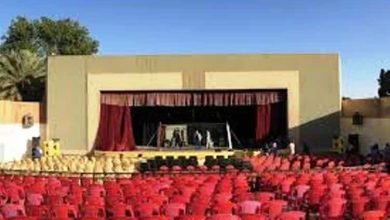How Did Sabreen Market Survive?

Sudan Events – Agencies
Before April 15 of last year, Sabreen Market in Omdurman was only mentioned by the residents of Karari locality when vegetable prices spiked at the popular Omdurman market. Otherwise, it was typically described without flattery: chaotic crowds, sewage water flooding its sides, narrow entrances, dusty roads, and pickpockets who snatch wallets in the blink of an eye. However, with ten months of war between the army and the Rapid Support Forces (RSF) passing by, and the destruction that has ravaged other markets in the Sudanese capital, Khartoum, Sabreen Market has entered a new phase in its history. It has now become the sole destination from which residents of both parts of Omdurman—those under army control and those under RSF control—acquire essential supplies of food, clothing, and medicine.
After the initial looting and thefts that affected Khartoum’s markets when the war began, Sabreen Market was largely overlooked by thieves who targeted businesses and public and private institutions in search of cash. Cash wasn’t expected to be found in the pockets of vegetable sellers or in the cheap, used clothes sold at Sabreen.
However, on May 3 of last year, the first attempted robbery occurred. Al-Abid Ibrahim, a shoe trader in the market, recounts: “The Sabreen branch of Bank of Khartoum was broken into and looted by armed individuals as part of the wave of bank thefts sweeping the capital. But since the thieves knew there was no cash inside modest shops, they didn’t touch the food, clothing, or shoes. Spices and food items were more abundant in other markets, which had been fully looted and were easier to access than Sabreen, where shop owners hadn’t deserted as they had in other markets.”
Adam Isaac, a flour trader who used to work in the Omdurman market near Al Hilal Stadium, told Atar that some traders moved their goods home, believing that “starting a business in Sabreen Market wasn’t an attractive idea; it was a modest market on the outskirts of the capital.” Despite this, Sabreen Market was poised for a new era, as it became a suitable place for the remaining traders in the capital, who brought in goods from Egypt, Saudi Arabia, Ethiopia, Turkey, and other countries. Isaac confirms: “Currently, Sabreen Market hosts 26 flour distribution centers that import flour from Egypt and Turkey,” a number that nearly matches the total flour distribution centers in Omdurman city before the war broke out. According to Isaac, the number of wholesale food stores has surpassed 90.
Babiker Fadlallah, who works as an agent for importers from Egypt, says Sabreen Market has become an alternative to Khartoum’s markets, which suffered widespread destruction and organized looting. Fadlallah told Atar that traders turned to importing foodstuffs from Egypt after the destruction of markets and the shutdown of local factories.
Sabreen Market was established in the mid-1990s to serve the residents of the northern neighborhoods of Karari locality, situated north of Omdurman. It had always been the least favored destination for shoppers out of the three main markets in Omdurman: Libya Market, the large Omdurman Market, and the popular market. Each had offerings that Sabreen Market lacked—Omdurman Market had household goods, food products from factories, and stores selling fine clothing for both men and women. Libya Market was the main hub for footwear, clothing, and textiles. The popular market was known for vegetables and spices. In contrast, Sabreen Market was seen as a modest stop, mainly for those living in the working-class neighborhoods of western Omdurman. It served primarily as a transit hub linking rural northern and western residents to the center of the capital.
After one month of war, by mid-April, local goods from national factories like soap, oil, tea, biscuits, pasta, and bottled water disappeared, replaced by products from Egypt. By mid-May, Egyptian goods were being transported directly from the Arqin and Old Halfa crossings to Sabreen Market in Omdurman.
Babiker Fadlallah explains the new import method traders adopted during the war: “Previously, a commercial registry and a bank credit letter were required to import any goods. During the war, the authorities replaced these procedures with a new system—traders had to pay a one percent fine on the value of the imported goods and full customs duties.”
This new system encouraged many who were not previously in the consumer goods trade to enter the import market. Many business owners in other fields abandoned their previous activities and began importing goods directly from Egypt. As a result, the number of food importers surged, and it became common for people with no prior experience in this type of business to get involved.
With the main markets in Khartoum devastated, everything that could be needed by people was being imported. Edible oils from Russia, Turkey, and Saudi Arabia appeared, along with goods from Libya, Ethiopia, and Uganda—all finding their way to Sabreen Market in Omdurman. However, the devaluation of the Egyptian pound against the dollar had an impact on food imports from Egypt, slowing down trade. The flow of goods from Egypt to Sabreen became much less than before.
Ten months into the war, buying activity slowed as people either exhausted their savings or restricted their daily needs to the bare essentials of food and drink. When RSF forces entered the Gezira state on December 19, food prices spiked sharply. Some factories in Gezira, which had supplied parts of Darfur, Kordofan, White Nile, and southern Khartoum, halted operations. This coincided with rising Egyptian goods prices due to the exchange rate of the dollar against the Egyptian pound.
Mohammed Siddiq, a retailer in Sabreen Market, told Atar that the price of a sack of Egyptian flour jumped from 11,000 pounds to 23,000, and the Turkish flour from 12,000 pounds to 24,000. The price of a 36-pound jerrycan of oil surged from 36,000 to 60,000 pounds, while the price of coffee rose from 1,200 to 4,000 pounds per pound, and tea went from 200 pounds to between 3,600 and 5,000 pounds per pound. The price of lentils, which people turned to due to economic hardship, increased from 1,000 pounds to 4,000 pounds. “Three packs of pasta used to sell for 1,000 pounds; now, one pack costs 1,000 pounds,” Siddiq added.
The price of a 15-kilogram sack of lentils jumped from 11,000 pounds to 30,000, and meat prices rose despite a lack of demand—lamb went from 6,000 pounds per kilogram to 9,000, and beef from 4,000 pounds to 7,000 pounds.
The movement of goods from Sabreen Market to large parts of the RSF-controlled Um Badda locality stopped for several months. However, according to three wholesale traders in the market, the authorities designated two days a week for goods to be delivered to Um Badda. Traders, preferring to remain anonymous, said it is now allowed for traders in Um Badda to transport goods twice a week. However, due to the lack of transportation, the presence of armed gangs, and the multiple checkpoints of both warring parties along the road between Sabreen Market and Um Badda, coupled with the high fees collected by both sides, only one trader would transport goods to the RSF-controlled areas at a time. Consequently, residents in these RSF-controlled areas of Um Badda and Omdurman suffer from severe food shortages because people cannot move between neighborhoods that have become military battlefields, and transport is not available.
In neighborhoods like Abbasiya, Banta, Al-Mawrada, Al-Arda, and Al-Hashimab in Omdurman, food supplies in homes and shops have been completely depleted due to restricted entry and exit from these areas. This has led residents to resort to hunting wild birds to survive hunger.



